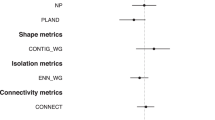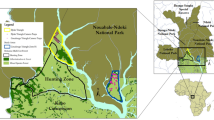Abstract
The impact of deforestation and fragmentation upon ecologically important and poorly known groups is currently an important issue for conservation biology. Herein we describe xenathran communities across the Brazilian Cerrado and study the effects of habitat fragmentation on occupancy and activity patterns on these assemblages. Our hypothesis was that larger and specialized species would be more ecologically sensitive, and likely to exhibit shifts in their activity patterns in more deforested areas as a way of dealing with the myriad of effects involved in the fragmentation process. The study was conducted by camera trapping in ten Cerrado sites. Five species were analyzed: Priodontes maximus, Euphractus sexcinctus, Dasypus novemcintus (Order Cingulata), Tamandua tetradactyla and Myrmecophaga tridactyla (Order Pilosa). Fragmentation was quantified by landscape metrics, calculated on scales that matched the species’ home ranges. Occupancy and detection probability analyses were conducted to test for shifts in occupancy under different fragmentation conditions. A mixed-effects model analysis was conducted to test for shifts in species’ frequency of records related to time of day, controlling for spatial autocorrelation by means of eigenvector-based spatial filters for the models’ residuals. There were no changes in activity pattern between more and less fragmented areas, so that our behavioural plasticity hypothesis was not corroborated for this group. The lack of changes in the patterns could be explained by a species’ time-lag response, or by the lack of a wide enough fragmentation gradient in our study.


Similar content being viewed by others
References
Ab’Saber AN (1983) O domínio dos Cerrados: introdução ao conhecimento. Rev Serv Púb 111:41–55
Anacleto TCS (2007) Food Habits of Four Armadillo Species in the Cerrado Area, Mato Grosso, Brazil. Zool Stud 46:529–537
Anacleto TCS, Marinho-Filho J (2001) Hábito alimentar do tatu canastra (Xenarthra, Dasypodidae) em uma área de Cerrado do Brasil Central. Rev Bras Zool 18:681–688
Andrén H (1994) Effects of habitat fragmentation on birds and mammals in landscapes with different proportions of suitable habitat: a review. Oikos 71:355–366
Bennington CC, Thayne WV (1994) Use and misuse of mixed model analysis of variance in ecological studies. Ecology 75:717–722
Beyer HL (2004) Hawth’s analysis tools for ArcGIS. http://www.spatialecology.com/htools. Accessed February 2010
Bierregaard RO Jr, Laurance WF, Sites JW et al (1997) Key priorities for the study of fragmented tropical ecosystems. In: Laurance WF, Bierregaard RO Jr (eds) Tropical forest remnants: ecology, management and conservation of fragmented communities. University of Chicago Press, Chicago, pp 515–525
Boulinier T, Nichols JD, Sauer JR et al (1998) Estimating species richness: the importance of heterogeneity in species detectability. Ecology 79:1018–1028
Burnham KP, Anderson DR (2002) Model selection and multimodel inference: a practical information-theoretic approach. Springer, New York
Carbone C, Christie S, Conforti K et al (2001) The use of photographic rates to estimate densities of tigers and other cryptic mammals. Anim Conserv 4:75–79
Carbone C, Christie S, Conforti K et al (2002) The use of photographic rates to estimate densities of cryptic mammals: response to Jennelle et al. Anim Conserv 5:121–123
Chiarello AG (1999) Effects of fragmentation of the Atlantic forest on mammal communities on south-eastern Brazil. Biol Conserv 89:71–82
Crooks KR (2002) Relative sensitivities of mammalian carnivores to habitat fragmentation. Conserv Biol 16:488–502
Diniz-Filho JAF, Bini LM (2005) Modelling geographical patterns in species richness using eigenvector-based spatial filters. Global Ecol Biogeogr 14:177–185
Eisenberg JF, Redford KH (1999) Mammals of the neotropics, vol 3. The University of Chicago Press, Chicago
Eisenberg JF, Thorington RW Jr (1973) A preliminary analysis of a neotropical mammal fauna. Biotropica 5:150–161
Eiten G (1972) The Cerrado vegetation of Brazil. Bot Rev 38:201–341
Encarnação C (1986) Contribuição à biologia dos tatus (Dasypodidae, Xenarthra) da Serra da Canastra, Minas Gerais. Thesis, Universidade Federal do Rio de Janeiro, Rio de Janeiro
ESRI (2009) ArcGIS 9.3.1—Geographical information system. Environment System Research Institute Inc., Readlands, California
Estrada A, Juan-Solano S, Martínez TO et al (1999) Feeding and general activity-patterns of a howler monkey (Alouatta palliata) troop living in a forest fragment at Los Tuxtlas, Mexico. Am J Primatol 48:167–183
Fahrig L (2003) Effects of habitat fragmentation on biodiversity. Annu Rev Ecol Syst 34:487–515
Garcia-Chiarello A (1993) Activity pattern of the brown howler monkey Alouatta fusca, [Geoffroy 1812] in a forest fragment of southeastern Brazil. Primates 34:289–293
Gardner TA, Barlow J, Chazdon R et al (2009) Prospects for tropical forest biodiversity in a human-modified world. Ecol Lett 12:561–582
Harmsen BJ, Foster RJ, Silver S et al (2010) Differential use of trails by forest mammals and the implications for camera-trap studies: a case study from Belize. Biotropica 42:126–133
Henle K, Davis KF, Kleyer M et al (2004) Predictors of species sensitivity to fragmentation. Biodiversity Conserv 13:207–251
Hijmans RJ, Cameron SE, Parra JL et al (2005) Very high resolution interpolated climate surfaces for global land areas. Int J Climatol 25:1965–1978
Hines JE (2006) PRESENCE 3.1. Software to estimate patch occupancy and related parameters. USGS-PWRC. Available at http://www.mbr-pwrc.usgs.gov/software/presence.html. Accessed August 2011
IBAMA (Brazilian Environmental Agency) (2009) Plano de Ação para Prevenção e Controle do Desmatamento e das Queimadas no Cerrado, Brasília, Brasil. Available at http://siscom.ibama.gov.br/monitorabiomas/Cerrado. Accessed December 2009
IBGE (Brazilian Institute of Geography and Statistics) (2004) Mapa de Biomas do Brasil Escala 1:5000000. Available at http://www.ibge.gov.br/home/presidencia/noticias/21052004biomas.shtm. Accessed September 2009
Jennelle CS, Runge MC, MacKenzie DI (2002) The use of photographic rates to estimate densities of tigers and other cryptic mammals: a comment on misleading conclusions. Anim Conserv 5:119–120
Jepsen JU, Topping CJ (2004) Modelling roe deer (Capreolus capreolus) in a gradient of forest fragmentation: behavioural plasticity and choice of cover. Can J Zool 82:1528–1541
Juarez KM, Marinho-Filho J (2002) Diet, habitat use, and home ranges of sympatric canids in central Brazil. J Mamm 83:925–933
Karanth KU, Nichols JD (1998) Estimation of tiger densities in India using photographic captures and recaptures. Ecology 79:2852–2862
Karanth KU, Chundawat RS, Nichols JD et al (2004) Estimation of tiger densities in the tropical dry forests of Panna, Central India, using photographic capture–recapture sampling. Anim Conserv 7:285–290
Lovejoy TE, Bierregaard Jr. BO, Rylands AB et al (1986) Edge and other effects of isolation on Amazon forest fragments. Soulé ME (ed) Conservation biology. The science of scarcity and diversity. Sinauer Associates, Sunderland, pp 257–285
Machado ABM, Drummond GM, Paglia AP (2008) Livro Vermelho da fauna brasileira ameaçada de extinção, vol 2. Fundação Biodiversitas, Belo Horizonte, Brazil
MacKenzie DI, Nichols JD, Hines JE et al (2003) Estimating site occupancy, colonization, and local extinction when a species is detected imperfectly. Ecology 84:2200–2207
MacKenzie DI, Nichols JD, Royle JA et al (2006) Occupancy estimation and modeling. Elsevier, Burlington
McNab BK (1985) Energetics, population biology and distribution of Xenarthrans, living and extinct. In: Montgomery GG (ed) The evolution and ecology of armadillos, sloths and vermilinguas. Smithsonian Institution Press, Washington, DC, pp 219–232
Medri IM, Mourão GM, Harada AY (2003) Dieta de tamanduá-bandeira (Myrmecophaga tridactyla) no Pantanal da Nhecolândia, Brasil. Edentata 5:29–34
Meritt DA Jr (1985) Naked-tail armadillos Cabassous sp. In: Montgomery GG (ed) The evolution and ecology of armadillos, sloths and vermilinguas. Smithsonian Institution Press, Washington, DC, pp 389–391
Metzger JP, Martensen AC, Dixo M et al (2009) Time-lag in biological responses to landscape changes in a highly dynamic Atlantic forest region. Biol Conserv 142:1166–1177
Miranda GHB (2004) Ecologia e conservação do tamanduá-bandeira (Myrmecophaga tridactyla, Linnaeus, 1758) no Parque Nacional das Emas. Dissertation, Universidade de Brasília
Mittermeier RA, Robles-Gil P, Hoffmann M et al (2004) Hotspots revisited. CEMEX, Mexico
Montgomery GG (ed) (1985a) The evolution and ecology of armadillos, sloths and vermilinguas. Smithsonian Institution Press, Washington, DC, pp 219–232
Montgomery GG (1985b) Movements, foraging and food habits of the four extant species of neotropical vermilinguas (Mammalia:Myrmecophagidae). In: Montgomery GG (ed) The evolution and ecology of armadillos, sloths and vermilinguas. Smithsonian Institution Press, Washington, DC, pp 365–377
Norris D, Michalski F, Peres CA (2010) Habitat patch size modulates terrestrial mammal activity patterns in Amazonian forest fragments. J Mamm 91:551–560
O’Brien TG, Kinnaird MF, Wibisono HT (2003) Crouching tigers, hidden prey: Sumatran tiger and prey populations in a tropical forest landscape. Anim Conserv 6:131–139
Onderdonk DA, Chapman CA (2000) Coping with forest fragmentation: the primates of Kibale National Park, Uganda. Int J Primatol 21:587–611
Pardini R, Souza SM, Braga-Neto R et al (2005) The role of forest structure, fragment size and corridors in maintaining small mammal abundance and diversity in an Atlantic forest landscape. Biol Conserv 124:253–266
Pinheiro J, Bates D (2000) Mixed-effects models in S and S-plus. Springer, New York
Pinheiro J, Bates D, DebRoy S et al (2011) nlme: linear and nonlinear mixed effects models, R package version 3.1-10. http://cran.r-project.org/web/packages/nlme/index.html. Accessed December 2009
Pires AS, Lira PK, Fernandez FAS et al (2002) Frequency of movements of small mammals among Atlantic Coastal Forest fragments in Brazil. Biol Conserv 108:229–237
R Development Core Team (2009) R: a language and environmental for statistical computing. R Foundation for Statistical Computing, Vienna. http://cranr-project.org. Accessed December 2009
Rangel TF, Diniz-Filho JAF, Bini LM (2010) SAM: a comprehensive application for spatial analysis in macroecology (version 4). Ecography 33:46–50
Redford KH (1985) Food habits of armadillos (Xenarthra:Dasypodidae). In: Montgomery GG (ed) The evolution and ecology of armadillos, sloths and vermilinguas. Smithsonian Institution Press, Washington, DC, pp 429–437
Rempel R (2006) Patch Analyst 3.0. Centre for Northern Forest Ecosystem Research, Lakehead University Campus, Ontario
Silveira L, Jácomo ATA, Furtado MM et al (2009) Ecology of the Giant Armadillo (Priodontes maximus) in the Grasslands of Central Brazil. Edentata 8–10:25–34
Silver S (2004) Assessing jaguar abundance using remotely triggered cameras. Wildlife Conservation Society, New York
Simberloff D (1998) Flagships, umbrellas and keystones: is single-species management passé in the landscape era? Biol Conserv 83:247–257
Swihart RK, Gehring TM, Kolozsvary MB et al (2003) Responses of ‘resistant’ vertebrates to habitat loss and fragmentation: the importance of niche breadth and range boundaries. Divers Distrib 9:1–18
Tews J, Brose U, Grimm V et al (2004) Animal species diversity driven by habitat heterogeneity/diversity: the importance of keystone structures. J Biogeogr 31:79–92
Tilman D, May RM, Lehman CL et al (1994) Habitat destruction and extinction debt. Nature 371:65–66
Trolle M (2003) Mammal survey in the southeastern Pantanal, Brazil. Biodiversity Conserv 12:823–836
Uezu A, Metzger JP, Vielliard JME (2005) Effects of structural and functional connectivity and patch size on the abundance of seven Atlantic Forest bird species. Biol Conserv 123:507–519
Wetzel RM (1985a) The identification and distribution of recent Xenarthra (=Edentata). In: Montgomery GG (ed) The evolution and ecology of armadillos, sloths and vermilinguas. Smithsonian Institution Press, Washington, DC, pp 5–21
Wetzel RM (1985b) Taxonomy and distribution of armadillos, Dasypodidae. In: Montgomery GG (ed) The evolution and ecology of armadillos, sloths and vermilinguas. Smithsonian Institution Press, Washington, DC, pp 23–46
Wiens JA (1989) Spatial scaling in ecology. Funct Ecol 3:385–397
Zuur AG, Ieno EN, Walker NJ et al (2009) Mixed effects models and extensions in ecology with R. Springer Science + Business Media, New York
Acknowledgments
We would like to give thanks for the Earthwatch Institute, the Monsanto Foundation, the Memphis Zoo and the CI Brazil for their financial support; the landowners for giving permission to work at their properties; the IBAMA for granting research licenses for working in protected areas; and the many volunteers and trainees who helped in the field. This study also received a technical support from the Núcleo Regional do DF da Rede ComCerrado/MCT. We would also like to thank the Graduate Program in Ecology of the University of Brasilia and the Brazilian National Council of Scientific and Technological Development (CNPq), for the scholarship awarded to Babi Zimbres and research grant to J. Marinho-Filho. FAPDF also provided financial support to JMF and RBM (Pronex 193000563-2009).
Author information
Authors and Affiliations
Corresponding author
Electronic supplementary material
Below is the link to the electronic supplementary material.
Rights and permissions
About this article
Cite this article
Zimbres, B., Furtado, M.M., Jácomo, A.T.A. et al. The impact of habitat fragmentation on the ecology of xenarthrans (Mammalia) in the Brazilian Cerrado. Landscape Ecol 28, 259–269 (2013). https://doi.org/10.1007/s10980-012-9832-2
Received:
Accepted:
Published:
Issue Date:
DOI: https://doi.org/10.1007/s10980-012-9832-2




